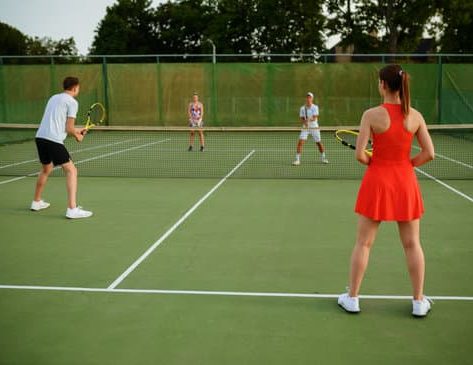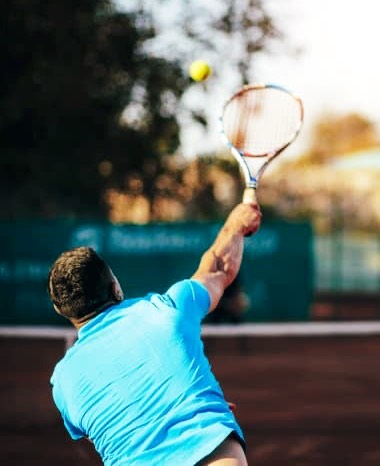
The importance of understanding tennis strategies, techniques, and practice routines
Success in tennis hinges on more than just raw athleticism and natural talent. To truly excel in this sport, players must develop a strong foundation of strategic thinking, refined techniques, and tailored practice routines. These elements are crucial for fostering continuous improvement, boosting on-court performance, and ultimately, achieving your tennis goals. Our research has encompassed a wide range of resources, including expert interviews, case studies, and scientific literature, to bring you the most effective and time-tested methods that can help you become a more well-rounded and formidable tennis player.
This comprehensive guide is designed to provide you with a wealth of information spanning various aspects of tennis, including singles and doubles strategies, court positioning and movement, anticipation of opponents’ moves, forehand and backhand techniques, volley and overhead shots, serve variations and tactics, as well as drills and practice routines for improving footwork, agility, and court coverage. Each section is crafted to offer in-depth knowledge and practical tips, ensuring that you have all the tools necessary to transform your game and take it to new heights.
Singles Strategies
When it comes to singles play, mastering baseline play is essential. A strong baseline game enables players to control rallies and dictate the pace of the match. Develop consistent groundstrokes, utilize topspin to create high-bouncing shots, and apply slice to change the rhythm and disrupt your opponent’s timing.
Incorporating attacking and defensive strategies is crucial to maintaining balance in your game. An aggressive strategy might include frequent approaches to the net, powerful serves, and deep, penetrating groundstrokes. On the other hand, a defensive strategy may involve focusing on consistency, utilizing lobs and passing shots, and capitalizing on opponents’ errors. The key is to strike the right balance between these approaches depending on your strengths and your opponent’s weaknesses.
Adapting to different playing styles is an important skill in singles matches. Recognize the nuances of your opponent’s game, whether they are a powerful server, a counterpuncher, or an all-court player, and adjust your tactics accordingly to exploit their vulnerabilities.
Doubles Strategies

Developing strong serving and returning strategies is essential in doubles. Aim for high-percentage serves that limit the risk of double faults, and target your returns at the server’s partner to put them under pressure. Mix up your serve and return placements to keep your opponents guessing.
Proper court coverage and teamwork are the foundations of a successful doubles team. Understand your partner’s tendencies and strengths, and position yourself to cover any gaps in the court. Efficient movement and anticipation can help you and your partner maintain control of the net and the point.
Court Positioning and Movement
Proper court positioning is crucial for maximizing your chances of winning points. Maintain a balanced and centered position when possible, ensuring you have enough time to react to your opponent’s shots. Avoid being caught too far behind the baseline or too close to the net, as this can leave you vulnerable to attack.
Effective movement techniques, such as split steps and lateral shuffles, can help you cover the court efficiently and maintain balance. Focus on explosive first steps and smooth transitions between forward, backward, and lateral movements.
Transitioning between offense and defense requires a keen awareness of your court position and your opponent’s intentions. Be prepared to shift from an aggressive stance to a defensive posture or vice versa, depending on the flow of the point and your opponent’s shots.
Anticipating Opponents’ Moves
Reading your opponent’s body language can give you crucial information about their intentions. Pay close attention to their racket preparation, footwork, and the direction they are facing, as these factors can provide valuable clues about their next shot.
Identify patterns and habits in your opponent’s game, such as favorite shot combinations or serve placements. By recognizing these tendencies, you can better anticipate their moves and be prepared to counter them effectively.
Adapting your game plan based on your opponent’s strengths and weaknesses is essential for success. Be flexible and willing to change your tactics as the match progresses, making adjustments in response to your opponent’s playstyle and strategies.
Forehand and Backhand Techniques
Understanding the fundamentals of forehand and backhand strokes is crucial for a strong baseline game. Focus on maintaining a balanced stance, proper grip, and consistent swing path. Generate power through a smooth kinetic chain, using your legs, hips, and torso to transfer energy to the ball.
Mastering topspin, slice, and flat shots will add variety and unpredictability to your game. Topspin shots create a high bounce and are ideal for aggressive play, while slice shots generate backspin and stay low, making them difficult for opponents to attack. Flat shots are hit with minimal spin and can be used to surprise your opponent with speed and placement.
Proper footwork and body mechanics are essential for executing efficient and powerful groundstrokes. Maintain a wide base, stay on the balls of your feet, and use small, quick steps to position yourself optimally for each shot.
Volley and Overhead Shots
Developing proper technique for volleys and overhead smashes is vital for success at the net. For volleys, maintain a firm grip, shorten your backswing, and focus on a compact, controlled swing. Overhead smashes require a strong shoulder turn, full extension, and an aggressive downward swing.
Transitioning from baseline to net play involves recognizing opportunities to approach, such as forcing your opponent into a defensive position with a deep, aggressive groundstroke. Use the split step as you approach the net to maintain balance and react quickly to incoming shots.
Effective volleys require precise timing and positioning. Anticipate your opponent’s shot, position yourself close to the net, and keep your racket out in front to maximize control and reaction time.
Serve Variations and Tactics

Serve placement and accuracy are crucial for successful serving. Aim for the corners and lines to force your opponent into uncomfortable positions, and vary your targets to prevent predictability.
Developing a reliable second serve is essential to avoid double faults and maintain pressure on your opponent. Focus on consistency and placement, often utilizing the kick serve to create a high bounce and limit your opponent’s attacking opportunities.
Tennis Drills and Practice Routines
Drills to Improve Footwork, Agility, and Court Coverage
Ladder and cone drills help develop quick, efficient footwork and improve agility. Incorporate these exercises into your practice routine to enhance your overall court coverage and movement.
Shadow swinging and ghosting involve mimicking your strokes and court movements without a ball. These drills help reinforce proper technique and movement patterns, translating to better performance during matches.
Speed and endurance training, such as sprints and interval workouts, are crucial for maintaining high energy levels and quick reactions throughout a match.
Targeted Practice Routines for Specific Shots or Strategies
Drills for improving groundstrokes focus on consistency, power, and accuracy. Practice hitting targets on the court, aiming for deep, penetrating shots that put your opponent on the defensive.
Volley and overhead practice routines involve repetition and precise footwork. Work on your net game by practicing various volley combinations and overhead smashes, honing your technique and reaction time.
Serve and return drills help develop consistency, placement, and variety. Focus on hitting specific targets, incorporating different serve types, and practicing aggressive returns.
Warm-up and Cool-down Routines for Optimal Performance
Dynamic stretching and warm-up exercises, such as leg swings, arm circles, and hip rotations, prepare your body for the physical demands of tennis and reduce the risk of injury.
Post-match cool-down and recovery techniques are essential for maintaining your body’s health and ensuring optimal performance. Incorporate static stretching, foam rolling, and gentle mobility exercises to relax your muscles, improve flexibility, and aid in recovery.
The importance of injury prevention and muscle care cannot be overstated. Consistent warm-up and cool-down routines, along with strength training and rest days, can help prevent overuse injuries and keep your body in top condition for the long term. Listening to your body and addressing any signs of discomfort or pain is crucial for maintaining a successful tennis career.
In conclusion, mastering tennis strategies, techniques, and practice routines is vital for players seeking to elevate their game and achieve success on the court. By focusing on singles and doubles strategies, court positioning and movement, and honing various tennis techniques, players can develop a well-rounded and adaptable game.

We’d love to hear about your progress and any feedback you may have on the strategies and techniques discussed in this post. Your experiences can help other players learn and grow, fostering a supportive tennis community.
As a final note, we invite you to check out our free ebook, “Mastering Tennis Patterns.” This valuable resource dives deeper into the world of tennis strategy, offering even more tips and insights to help you develop your game. By understanding and mastering tennis patterns, you’ll be well on your way to becoming a skilled and successful player.
